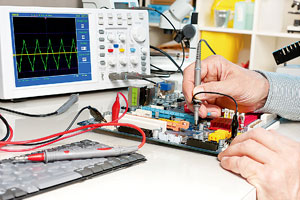BE Final Year Project - A Reflection on the Passion of Graduating Students
Sakshi Education

1)The Importance of the Project Work
The final year project is one of the most important aspects of engineering degree. Engineering is a profession in which knowledge of the mathematical, computational, and natural sciences gained by study, experience, and practice is applied with judgment to develop economically effective use of matter, energy, and information to the benefit of humankind.
The final year project is one of the primary mechanisms to provide students with an opportunity to experience the practical, effective, and beneficial application of what they have been studying for the past several years.
The final year project will be student’s first exposure to the full rigor of engineering practice. It is essential that they learn from this exposure and utilize latest engineering methodologies involved. It is particularly important that students should learn not just to apply what they know, but to apply it with judgment, with the ability to assess what they are doing and to be critical of it. There is another reason why final year project is so important: it will inevitably be used as a discriminator to decide how good an engineering student one was. Hence, the project work should reflect the technical passion of the graduating students.
2) Selection and execution of Project Work
 The student must identify and select the project work as per his/her field of interest and keeping in mind his future area of work. For undergraduates, students are permitted to work in teams for the Project work, although some students work independently. The team strength should not exceed three members to ensure good participation of all team members.
The student must identify and select the project work as per his/her field of interest and keeping in mind his future area of work. For undergraduates, students are permitted to work in teams for the Project work, although some students work independently. The team strength should not exceed three members to ensure good participation of all team members.
After identifying two or three topics, the students can approach their faculty guide and take his/her inputs before finalizing on a single topic. Do not expect the faculty to offer you topics. After finalizing the topic, the students have to undergo literature study to get a comprehensive understanding on topic and research done in that particular area.
After preliminary literature survey, students should write down the problem statement, objectives of their project work and techniques or methodologies that they plan to employ to achieve their project objectives. They can then take up a deeper study into the theoretical aspects of the narrowed down topic and select the path to be followed to arrive at solutions.
The project works may involve one or more aspects of design, experimental, computational, coding or analytical mode. While experimental works needs equipment and associated instrumentation available in the college labs or outside, the computational works needs software and relevant exposure to use such software. The students can also write their own programs/code in any of the programming languages that they are conversant with. If necessary, they need to learn new subject areas out of their curriculum. Sometimes the project may involve inter disciplinary knowledge.
The students may also use numerical methods to solve differential equations formulated for their work based on fundamental conservation equations describing the physics of the problem under consideration. For example, Civil or Mechanical Engineering students may use Computational Fluid Dynamics or Finite Element Methods to model the problem to get solutions. Electronics or Electrical Engineering students may use MATLAB software. Computer /IT Students may use latest technical tools available in writing programs for the problem at hand. It is suggested that they prefer employing open source ware over commercial software in their project work. It is important that all the project team members make good individual contributions and work as a team to complete the Project within stipulated time. There may be cases where at some point of time during the course of project work, one needs to change the project objectives and search for alternative approaches for realizing such objectives. The students will face obstacles in their course of project work and they should overcome such hurdles thinking differently and innovatively.
The students are allotted two semesters during their final year for doing the project work. However, they can start identifying a topic of their interest during pre-final year itself. Unfortunately, majority of the students do not start the work early, until the end of last semester leading to poor and limited work with no built in analysis. There are many commercial coaching centers who sell already submitted project works at a price. Students should not adopt such unethical practices of lifting other project works. It is the duty of each student to plan well ahead of time and undertake an exhaustive and interesting project conceived on their own with an aim to satisfy the requirements of the degree in a professional manner. After the Project work is completed, it needs to be documented in the form of a Project thesis/ dissertation for submission to the College which leads to the award of the degree.
3) Project Report Format for Engineering Students
Project report is a written evidence of tasks, processes and activities that are undertaken and accomplished by the students while pursuing their projects and implementing it.
The project report is an official document that reflects precise and concrete information about the different aspects of the project ranging from the overview, requirements, practical aspects, theoretical considerations, tasks furnished, outcomes gained, objectives listed, reports attached, abstracts, experiments and results, conclusions and recommendations to the implementation and scope of the project.
Thus, a project report provides complete information about the project to the reader, and therefore, it is a mandatory document that must be submitted to the respective department heads after the successful completion and implementation of the projects.
More often than not such a valuable project report is poorly drafted and presented, and therefore fails to attract the attention of the departmental authorities who usually conduct exams. Apart from this, such a poorly drafted report not even gets proper attention from its readers as well. Eventually, it leads to poor impression, and the possessor of such a report usually scores low marks in projects.
Let us understand the format of Project Report. The sequel of pages and their hierarchical arrangement play a pivotal role in structuring the project report properly and interlinking the vital elements of the report in the best possible format. The ideal structure and format of the Project report is as follows:
1) Title & Cover Page
2) Declaration
3) Approval or Certification
4) Acknowledgements
5) Abstract
6) Table of Contents
7) List of Figures
8) List of Tables
9) List of Symbols and Abbreviations
10) Introduction
11) Body of the Project & the Chapters
12) Experiments and Results
13) Conclusion and Recommendations
14) Future Scope
15) References
16) Appendices
The final year project is one of the most important aspects of engineering degree. Engineering is a profession in which knowledge of the mathematical, computational, and natural sciences gained by study, experience, and practice is applied with judgment to develop economically effective use of matter, energy, and information to the benefit of humankind.
The final year project is one of the primary mechanisms to provide students with an opportunity to experience the practical, effective, and beneficial application of what they have been studying for the past several years.
The final year project will be student’s first exposure to the full rigor of engineering practice. It is essential that they learn from this exposure and utilize latest engineering methodologies involved. It is particularly important that students should learn not just to apply what they know, but to apply it with judgment, with the ability to assess what they are doing and to be critical of it. There is another reason why final year project is so important: it will inevitably be used as a discriminator to decide how good an engineering student one was. Hence, the project work should reflect the technical passion of the graduating students.
2) Selection and execution of Project Work
 The student must identify and select the project work as per his/her field of interest and keeping in mind his future area of work. For undergraduates, students are permitted to work in teams for the Project work, although some students work independently. The team strength should not exceed three members to ensure good participation of all team members.
The student must identify and select the project work as per his/her field of interest and keeping in mind his future area of work. For undergraduates, students are permitted to work in teams for the Project work, although some students work independently. The team strength should not exceed three members to ensure good participation of all team members.After identifying two or three topics, the students can approach their faculty guide and take his/her inputs before finalizing on a single topic. Do not expect the faculty to offer you topics. After finalizing the topic, the students have to undergo literature study to get a comprehensive understanding on topic and research done in that particular area.
After preliminary literature survey, students should write down the problem statement, objectives of their project work and techniques or methodologies that they plan to employ to achieve their project objectives. They can then take up a deeper study into the theoretical aspects of the narrowed down topic and select the path to be followed to arrive at solutions.
The project works may involve one or more aspects of design, experimental, computational, coding or analytical mode. While experimental works needs equipment and associated instrumentation available in the college labs or outside, the computational works needs software and relevant exposure to use such software. The students can also write their own programs/code in any of the programming languages that they are conversant with. If necessary, they need to learn new subject areas out of their curriculum. Sometimes the project may involve inter disciplinary knowledge.
The students may also use numerical methods to solve differential equations formulated for their work based on fundamental conservation equations describing the physics of the problem under consideration. For example, Civil or Mechanical Engineering students may use Computational Fluid Dynamics or Finite Element Methods to model the problem to get solutions. Electronics or Electrical Engineering students may use MATLAB software. Computer /IT Students may use latest technical tools available in writing programs for the problem at hand. It is suggested that they prefer employing open source ware over commercial software in their project work. It is important that all the project team members make good individual contributions and work as a team to complete the Project within stipulated time. There may be cases where at some point of time during the course of project work, one needs to change the project objectives and search for alternative approaches for realizing such objectives. The students will face obstacles in their course of project work and they should overcome such hurdles thinking differently and innovatively.
The students are allotted two semesters during their final year for doing the project work. However, they can start identifying a topic of their interest during pre-final year itself. Unfortunately, majority of the students do not start the work early, until the end of last semester leading to poor and limited work with no built in analysis. There are many commercial coaching centers who sell already submitted project works at a price. Students should not adopt such unethical practices of lifting other project works. It is the duty of each student to plan well ahead of time and undertake an exhaustive and interesting project conceived on their own with an aim to satisfy the requirements of the degree in a professional manner. After the Project work is completed, it needs to be documented in the form of a Project thesis/ dissertation for submission to the College which leads to the award of the degree.
3) Project Report Format for Engineering Students
Project report is a written evidence of tasks, processes and activities that are undertaken and accomplished by the students while pursuing their projects and implementing it.
The project report is an official document that reflects precise and concrete information about the different aspects of the project ranging from the overview, requirements, practical aspects, theoretical considerations, tasks furnished, outcomes gained, objectives listed, reports attached, abstracts, experiments and results, conclusions and recommendations to the implementation and scope of the project.
Thus, a project report provides complete information about the project to the reader, and therefore, it is a mandatory document that must be submitted to the respective department heads after the successful completion and implementation of the projects.
More often than not such a valuable project report is poorly drafted and presented, and therefore fails to attract the attention of the departmental authorities who usually conduct exams. Apart from this, such a poorly drafted report not even gets proper attention from its readers as well. Eventually, it leads to poor impression, and the possessor of such a report usually scores low marks in projects.
Let us understand the format of Project Report. The sequel of pages and their hierarchical arrangement play a pivotal role in structuring the project report properly and interlinking the vital elements of the report in the best possible format. The ideal structure and format of the Project report is as follows:
1) Title & Cover Page
2) Declaration
3) Approval or Certification
4) Acknowledgements
5) Abstract
6) Table of Contents
7) List of Figures
8) List of Tables
9) List of Symbols and Abbreviations
10) Introduction
11) Body of the Project & the Chapters
12) Experiments and Results
13) Conclusion and Recommendations
14) Future Scope
15) References
16) Appendices
In the above structure, the first nine items are known as preliminary pages, and are usually numbered with the Roman numerals as i, ii, iii, iv, and so on, except the title page.
The length of the overall document should be around 80 to 100 pages for it to be an effective project report.
The length of the overall document should be around 80 to 100 pages for it to be an effective project report.
Abstract:
This represents a summarized report of the complete project in a very concise and informative format covering main objective and aim of the project, the background information, processes and methods used, and methodologies implemented, followed with a brief conclusion of two to three lines talking about the results and scope of the project.
The entire abstract of a project report should be written in about 250 to 350 words, and therefore, should not exceed any further.
Table of Contents, List of Figures and Tables
Table of contents provides a complete sketch of the title, subtitles, headings, topics and the project elements that are involved in those headings. In other words, different sections and their titles are included here.
The whole project report in a nutshell is made known in the table of contents section, and therefore, it should include the titles of the first, second and third level headers, and must give a clear picture of the report to the reader.
Similarly, a list of figures and tables helps the reader to locate diagrams, charts and tables in the document, and therefore, it should be numbered accordingly by chapter and page number. It is not necessary to indicate page numbers for symbols and abbreviations used in the document.
The Main Body of the Project
The main body of the project should comprise several chapters with the corresponding titles, and each page within these chapters must be numbered in numerals as page numbers. The usual way of presenting these chapters is given below.
Chapter 1: Introduction chapter. This chapter should contain brief background information about the project, the methodology implemented for problem solving and the outlines of the results and future scope of the project. It rarely contains drawings and graphical illustrations.
Chapter 2: Chapter of Literature Review. It evaluates the current work with the previous one. It depicts the current implementations that overcome the previous problems and limitations of the project, and draws the attention and focus on the foreknowledge work that would be conducted based on the ongoing work at present. It must be clear and simple to understand.
Chapter 3-4 or 5: These chapters describe the overall in-depth information about the project. These chapters also involve the basic theoretical information about each and every component & aspect of the project, such as experimental setup,circuit design, simulation implementation and modeling, software implementation, statistical analysis and calculations done, results gained, and so on.
The appropriate information should always be accompanied with pictorial representations, tabular demonstrations, diagrams, flow charts, visible graphs, Images, photos other representations and depictions of the project, along with simulation results with good resolution and clarity.
Conclusion and Recommendations: The conclusion and recommendations part summarizes the whole report by highlighting the salient outcomes and their significance and the importance of the project and about the achievements.
The recommendations are interlinked with conclusion. The conclusion drawn from the project report can be further implemented in the recommendation section to overcome the constraints of the project.
Referencing and Appendices
The project report must be considered as a very standard report, and therefore, it should follow all rules, guidelines and protocols of gathering and presenting information, and implementing that and drawing conclusions out of it.
All these activities require appropriate and authentic sources of information and that particular information must be referenced or cited according to the copyrights and other guidelines. Therefore, to make the report original, it should be free from plagiarism and must follow standard citations and guidelines of citations to represent the reference names.
The appendices of a project report should contain the information which is appropriate and added to the main text like C program code, raw data, and so on.
4) Ideal Project work
Students should choose a project that allows them to display specific domain knowledge. A great project would solve a problem in a particular area of interest. They should use not only use the skills that they have learned in their classes, but also acquire new skills to build something unprecedented. The Project work should yield good results/ outcomes which are new contributions to the available knowledge base in that field. Ideally, students should be able to publish at least two papers in Conferences/ Journals so that they communicate their technical achievements with the research and other academic fraternity. It is good if the project is able to address some problems in the society and result in product innovations. Such innovations may lead to entrepreneurial ventures resulting in establishment of startup companies. Thus, the graduating students may become Job creators rather than Job seekers !
The entire abstract of a project report should be written in about 250 to 350 words, and therefore, should not exceed any further.
Table of Contents, List of Figures and Tables
Table of contents provides a complete sketch of the title, subtitles, headings, topics and the project elements that are involved in those headings. In other words, different sections and their titles are included here.
The whole project report in a nutshell is made known in the table of contents section, and therefore, it should include the titles of the first, second and third level headers, and must give a clear picture of the report to the reader.
Similarly, a list of figures and tables helps the reader to locate diagrams, charts and tables in the document, and therefore, it should be numbered accordingly by chapter and page number. It is not necessary to indicate page numbers for symbols and abbreviations used in the document.
The Main Body of the Project
The main body of the project should comprise several chapters with the corresponding titles, and each page within these chapters must be numbered in numerals as page numbers. The usual way of presenting these chapters is given below.
Chapter 1: Introduction chapter. This chapter should contain brief background information about the project, the methodology implemented for problem solving and the outlines of the results and future scope of the project. It rarely contains drawings and graphical illustrations.
Chapter 2: Chapter of Literature Review. It evaluates the current work with the previous one. It depicts the current implementations that overcome the previous problems and limitations of the project, and draws the attention and focus on the foreknowledge work that would be conducted based on the ongoing work at present. It must be clear and simple to understand.
Chapter 3-4 or 5: These chapters describe the overall in-depth information about the project. These chapters also involve the basic theoretical information about each and every component & aspect of the project, such as experimental setup,circuit design, simulation implementation and modeling, software implementation, statistical analysis and calculations done, results gained, and so on.
The appropriate information should always be accompanied with pictorial representations, tabular demonstrations, diagrams, flow charts, visible graphs, Images, photos other representations and depictions of the project, along with simulation results with good resolution and clarity.
Conclusion and Recommendations: The conclusion and recommendations part summarizes the whole report by highlighting the salient outcomes and their significance and the importance of the project and about the achievements.
The recommendations are interlinked with conclusion. The conclusion drawn from the project report can be further implemented in the recommendation section to overcome the constraints of the project.
Referencing and Appendices
The project report must be considered as a very standard report, and therefore, it should follow all rules, guidelines and protocols of gathering and presenting information, and implementing that and drawing conclusions out of it.
All these activities require appropriate and authentic sources of information and that particular information must be referenced or cited according to the copyrights and other guidelines. Therefore, to make the report original, it should be free from plagiarism and must follow standard citations and guidelines of citations to represent the reference names.
The appendices of a project report should contain the information which is appropriate and added to the main text like C program code, raw data, and so on.
4) Ideal Project work
Students should choose a project that allows them to display specific domain knowledge. A great project would solve a problem in a particular area of interest. They should use not only use the skills that they have learned in their classes, but also acquire new skills to build something unprecedented. The Project work should yield good results/ outcomes which are new contributions to the available knowledge base in that field. Ideally, students should be able to publish at least two papers in Conferences/ Journals so that they communicate their technical achievements with the research and other academic fraternity. It is good if the project is able to address some problems in the society and result in product innovations. Such innovations may lead to entrepreneurial ventures resulting in establishment of startup companies. Thus, the graduating students may become Job creators rather than Job seekers !
Published date : 10 Apr 2015 03:45PM



















